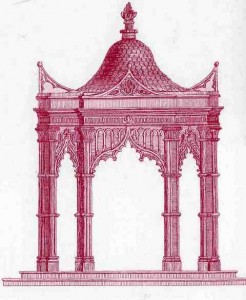The Garden Pavilion
A carved wooden pavilion in the Gothick taste, from Wallis’s “Carpenter’s Treasure,” c. 1793
“A light, sometimes ornamental, roofed structure, used at parks or fairs for amusement or shelter.” [Source: (2nd definition) The American Heritage Dictionary]
According to my other favorite source, The Oxford Companion to Gardens (1986, Oxford University Press), the Pavilion is both historic and contemporary in its popularity:
A widely occurring garden feature even today.
Many fine Renaissance examples are to be found in Italy. . . . Perhaps the most beautiful French pavilion is the Petit Trianon at Versailles. Especially fine examples are found in the Russian gardens inspired by the French model, such as the Temple of Friendship at Pavlovsk and the Agate Pavilion at Tsarskoye Selo (Pushkin). Notable 18th c. English examples are at Stowe and Wrest.
The Chinese have built many splendid and elaorately decorated pavilions, the finest perhaps being in the Winter Palace, Beijing, and the spectacular Temple of Heaven. . . . Likewise, Mogul gardens were not completely without a pavilion, where one sat to admire the cool shady garden. A splendid example is the 17th c. pavilion at Shalamar Bagh, Kashmir, which has black marble columns and a cascade of cooling water.









